Disneyland turns 50: Magic survives as the kingdom has grown
But critics see a flawed fantasyland
By Dorothy Korber -- Bee Staff Writer
Published 2:15 am PDT Sunday, May 1, 2005
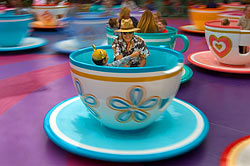
Sacramento Bee/Randy Pench
Disneyland, a place both timeless and frozen in time, hits a milestone this summer when it turns 50. Its trademark castle - now an icon as recognizable as the Eiffel Tower or the Statue of Liberty - is newly gilded for the park's golden anniversary kickoff on Thursday.
But not everybody sees the self-proclaimed Happiest Place on Earth as exactly that. A feisty band of critics questions the ethics of sugar-coating history, of drawing a veil of pixie dust over children's imaginations and of putting a hefty price tag on family fun.
"The most pernicious thing about Disneyland is it steals the imagination by trying to construct total environments," said Dean MacCannell, who wrote a pioneering study of tourism and teaches landscape architecture at the University of California, Davis. "The Disney message is simple: You don't need to have imagination - we'll do all that for you, for a fee."The critics critics fire back that a little pixie dust never hurt anyone. Besides, they observe, the place is beautiful. And fun. And squeaky clean.
"These academics who would prefer a stainless-steel utopia where you get in free and are exposed to real-life horrors - well, let them have it," said art historian Karal Ann Marling, a pro-Disneyite who teaches at the University of Minnesota. "The rest of us want to have fun with our kids."
All agree, though, that Walt Disney's brainchild has changed the cultural landscape of America, as well as the way America is perceived around the globe. His vision merged business and pleasure in a swirl of color and fantasy, with a nod to history and a spine-tingling little thrill of adventure.
And, in every corner of the Magic Kingdom, the park is a marketplace for Disney's other brainchildren: the movies and toys and TV shows and even the distinctive round ears of a certain beloved - and be-gloved - mouse.
"The term for that kind of thing is synergy, and it explains a lot about Disney's commercial success," said John Theobald, an expert on mass culture who teaches at UC Davis. "How can one medium reinforce and stimulate consumption by using another medium? Walt pioneered that idea as part of his business plan right from the start."
Synergy pays. Today, between 80 million and 100 million Americans use a Disney product daily, Theobald said. "That's one-third of the U.S. population. That's the reach of Disney."
Disneyland also reflects Walt Disney's legendary perfectionism, which dictated everything from the length of his employees' sideburns to the height of his mini-Matterhorn (147 feet, precisely 1/100th of the real mountain in Switzerland). But Disneyland was far from perfect when it opened to invited guests on July 17, 1955.
That day, kids, was a disaster that even Tinkerbell couldn't avert.
Freshly poured asphalt softened in the summer heat, trapping women's high-heeled shoes. The drinking fountains were dry. Half the attractions broke down. Disney sent out 15,000 invitations, but the passes were so easy to counterfeit, 28,000 people showed up.
The whole chaotic scene was broadcast live on ABC, then the network home of the "Disneyland" television program and - more synergy - a financial partner in the theme park.
The rocky opening day is described in detail in "Mouse Tales," a book by Orange County journalist David Koenig that takes a look behind the scenes at Disneyland.
On an overcast Monday recently, Koenig strolled down Main Street USA, noting original features from 1955 and talking about how Disneyland has changed over 50 years.
He pointed to a lamp shining behind a lace curtain above the faux firehouse near the park entrance. The window is in an apartment Disney built for overnight stays in his kingdom. The light has stayed lit since Disney's death Dec. 15, 1966.
"In the early mornings when the park was empty, Walt used to grab a cup of coffee and wander down Main Street in his bathrobe," Koenig said. "He'd notice little things that were amiss and tell the staff to fix them."
An aerial photo in Koenig's book shows Disneyland of 1955 as a pretty sparse Magic Kingdom, with lots of bald spots and orange groves on its outskirts. No Matterhorn, no Haunted Mansion, no Pirates of the Caribbean.
When it opened, Disneyland consisted mostly of the carousel and carnival-style rides in Fantasyland, the Jungle Boat cruise in Adventureland, and the Golden Horseshoe Saloon and Mark Twain riverboat in Frontierland. The boat paddled around an empty island on a moat dubbed "The Rivers of America."
But the glummest part of the Happiest Place on Earth was Tomorrowland, thrown together at the last moment and padded with county-fair type displays by non-Disney businesses.
"Only five Tomorrowland exhibits and attractions were ready on opening day," Koenig said.
Tomorrowland supposedly was a glimpse of life in far-off 1986. Kaiser sponsored the Hall of Aluminum Fame with its mascot, an all-aluminum pig. A few months later, the Crane Co. added its contribution: the Bathroom of Tomorrow and the Laundry of the Future.
It would be decades before Space Mountain and George Lucas' Star Tours spiced up this hapless corner of the kingdom. Actually, that, too, was part of Disney's vision - that the park would be constantly changed and improved.
Though skeptics called the park "Walt's Folly" after its troubled opening, Disney had the last laugh. During its first two months, a million people visited Disneyland.
Koenig enthusiastically chronicles the park's seamy side - real rats on Tom Sawyer's island, gory accidents in the Matterhorn's early days, visitor assaults on hapless characters dressed in clumsy costumes. Still, the middle-aged journalist counts himself among Disney's biggest fans.
"I love Disneyland - seriously," he said, peering up at a heroic statue of Walt walking hand-in-glove with Mickey Mouse. "It is the happiest place on Earth. But it's not perfect."
Whatever its impact on California and the world, Disneyland is certainly an icon in academic circles. The theme park has fueled endless debates, been dissected in doctoral dissertations and sparked whole conferences. Cultural geographer Stacy Warren has her own wry name for the phenomenon: Theoryland.
"It raises fascinating questions," said Warren, who is on the faculty at Eastern Washington University. "There's so little middle ground: Either Disney is a terrible cult trying to transform America or they are reformers with a genuine set of ideals that resonate with people."
Non-academic visitors may have their own practical criticisms of Disneyland - the escalating cost of admission or the length of the lines on a summer day. But scholars who scrutinize the Disney phenomenon have more subtle concerns. They wonder about the deeper messages transmitted by the place.
Carole Blair, a professor of rhetoric at the University of North Carolina, studies the cultural significance of American commemorative places. She worries about the pervasive sway of Disney on children.
"Disney has such a profound influence on kids that it's really impossible to escape," she said. "This is one of the ways our kids are educated. And that brings up another issue that troubles academics. Disney presents a view of American history that is cheerful and pleasing but not always true. And there's been an explosion of interest in how Disney handles issues of gender and race."
Professor MacCannell, one of Disney's most vocal critics, discerns an underlying political agenda.
"Disneyland is very political in a deep sense, because it wants to control the way the U.S. understands itself," he said. "Not only control it, but pretend that the more egregious things - things like nuclear bombs and slavery - never happened. It hangs a veil over those parts of history. I'm certain, if Disney were allowed free rein, that we would be living in a very foolish, juvenile world."
Balderdash, retorts professor Marling.
"Disneyland is not a museum," stressed the art historian, speaking from her home in Minnesota. "I keep coming back to that. This is a park about America's mythic history, and yes, it has very little awfulness in it. The truth is, America's mythic history has very little awfulness in it.
"This is an entertainment center. Do you really want to eat your ice cream cone next to wailing, screaming horrors? Decapitations and floggings? I think not."
Walt Disney did have an agenda, according to Marling. He wanted to create a beautiful, safe place where children could have fun with their parents. He based Disneyland as much on the pedestrian neighborhoods of Paris, with their lovely squares and impressive monuments, as on an idealized American main street.
And, Marling said, Disney wasn't ashamed of making money.
"Walt Disney was very aware that this is a capitalist country and that he was part of that system," she said. "He had to make money; he mortgaged his future on this park."
He did make money. His economic success rippled far beyond 160 acres in rural Anaheim. The Disney Co. now operates or licenses 10 theme parks on three continents, with another under construction in Hong Kong; it produces motion pictures, records, books and toys under numerous labels; and it owns both ABC and ESPN, among other media enterprises.
"Disney is our largest Fortune 500 company in Southern California," said Jack Kyser, chief economist for the Los Angeles County Economic Development Corp. "Disneyland transformed tourism here. When surveys are done on what draws people to visit Southern California, people talk about the beaches and Hollywood, but Disneyland is always at the top of the list."
This doesn't surprise Warren, the cultural geographer. Although her recent lecture on Disney theme parks was titled "The Evil Empire," she doesn't consider herself a Disney basher.
"You know, the fact that Disney created a setting that has generated so much debate is wonderful in itself," she said. "I'm so curious to see what the next 50 years brings to Disneyland - and if I can afford the entrance fee."
"The truth is, people keep going to Disneyland," she added. "Why do they do that? Because it is lots of fun."
That answer seemed obvious to the Castros, a family who recently journeyed from their home in Loomis to enjoy a few days at Disneyland. On the Mad Tea Party ride in Fantasyland, Phil Castro and his 5-year-old son, Armando, grinned and squealed as they gave the giant crockery a final twirl. Then they dismounted and stumbled woozily from the ride.
Phil Castro first rode the teacups in 1957, when he came to Disneyland as a 9-year-old. He said his family caught the train in Roseville and made the daylong trek to the Magic Kingdom by rail.
"I was excited the whole way," Castro recalled, as his mouse-earred son swung a plastic saber. "I still feel the magic."
SPEAKING DISNEY
Since the beginning, Disneyland has been a world apart. So, naturally, it has its own language, starting with "pixie dust" to describe the theme park's unique - and mandatory - spirit of happy magic. New hires attend Disney University, where they are indoctrinated in the Disney Way and learn a new vocabulary:| DISNEYESE | ENGLISH |
|---|---|
| Cast member | Employee |
| Role | Job |
| Guest | Customer |
| Audience | Crowd |
| Attraction | Ride |
| Security host | Guard |
| Presenteeism | Employee attendance rate |
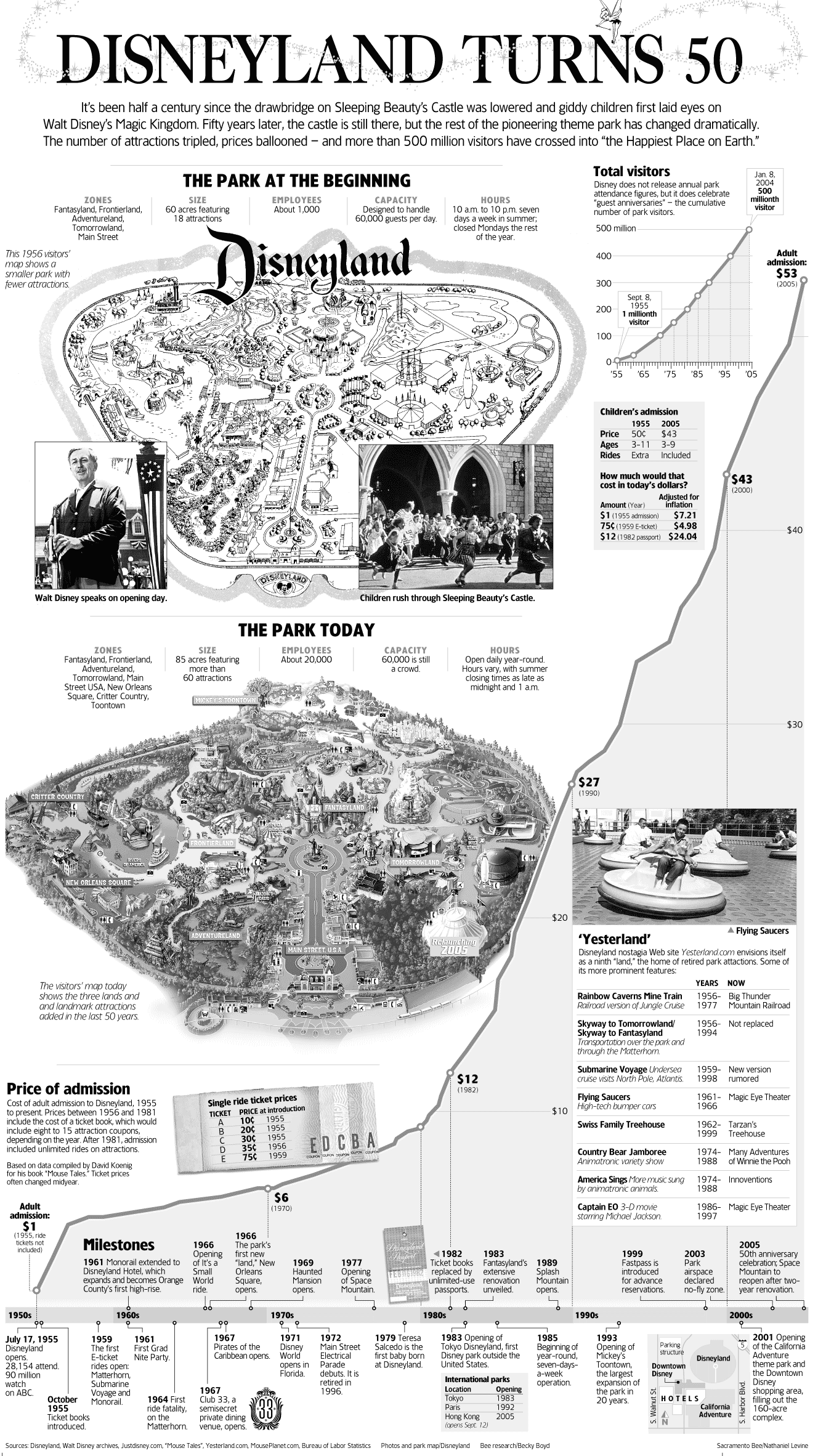
Disneyland Turns 50
Click picture for larger image
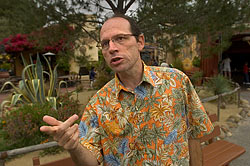
David Koenig, left Orange County journalist and author of “Mouse Tales”
Sacramento Bee/Randy Pench
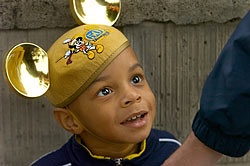
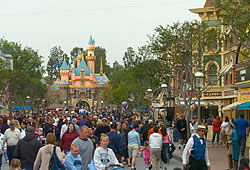
Sacramento Bee/Randy Pench
http://www.sacbee.com/content/news/story/12819953p-13670137c.html